
The Way to the Stars is a 1945 Anglo-American black-and-white Second World War drama film made by Two Cities Films. The film was produced by Anatole de Grunwald, directed by Anthony Asquith, and stars Michael Redgrave, John Mills, Rosamund John, and Stanley Holloway. In the United States it was shortened by 22 minutes, and the shortened version was distributed by United Artists under the title Johnny in the Clouds.

A Stranger Came Home is a 1954 British film noir directed by Terence Fisher and starring Paulette Goddard, William Sylvester and Patrick Holt. It is based on the 1946 novel Stranger at Home, credited to actor George Sanders but ghostwritten by Leigh Brackett. The film was released in the United States by Lippert Pictures.

Four Flies on Grey Velvet is a 1971 giallo film written and directed by Dario Argento. The film concerns Roberto Tobias, who accidentally kills a man and is then tormented by someone who witnessed the event. The film was an Italian and French production between the Rome-based company Seda Spettacoli and the Paris-based Universal Productions France.

Siege of the Saxons is a 1963 British adventure film directed by Nathan H. Juran and released by Columbia Pictures. Starring Janette Scott and Ronald Lewis, the film is set in the time of King Arthur, but, as with many Arthurian themed films, the sets and style are from medieval England. The plot is also heavily influenced by Robin Hood.
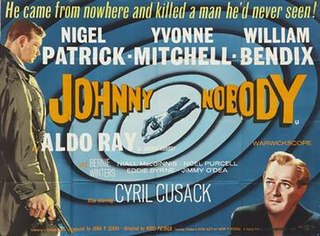
Johnny Nobody is a 1961 British drama film made in Ireland and directed by Nigel Patrick, starring Yvonne Mitchell, William Bendix and Aldo Ray. It was produced John R. Sloan for Viceroy Films, with Irving Allen and Albert R. Broccoli as executive producers. A man arrested for murder claims to be suffering from amnesia. Father Carey investigates the case, and looks for the killer's motive.
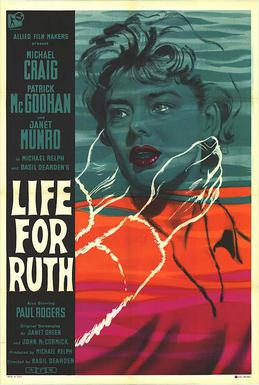
Life for Ruth is a 1962 British drama film produced by Michael Relph directed by Basil Dearden and starring Michael Craig, Patrick McGoohan and Janet Munro.

Town on Trial is a 1957 British mystery film directed by John Guillermin and starring John Mills, Charles Coburn, Barbara Bates and Derek Farr. A whole town comes under suspicion when two grisly murders are carried out—particularly members of the local sports club.
The Horror of It All is a 1964 British horror comedy film directed by Terence Fisher and with a screenplay by Ray Russell. It stars Pat Boone and Erica Rogers.
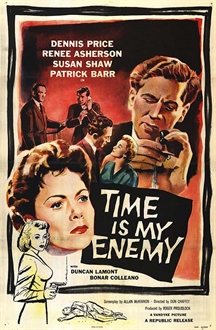
Time Is My Enemy is a 1954 British crime film directed by Don Chaffey and starring Dennis Price, Renée Asherson and Patrick Barr.

The File of the Golden Goose is a 1969 British neo noir thriller film directed by Sam Wanamaker and starring Yul Brynner, Charles Gray and Edward Woodward. Its plot involves an American detective being sent to Britain to track down a major international criminal.

The Long Haul is a 1957 British drama film directed by Ken Hughes and starring Victor Mature, Patrick Allen and Diana Dors. It is based on the novel The Long Haul by Mervyn Mills.

Ruth Dunning, born Mary Ruth Dunning, was a Welsh actress of stage, television, and film. Although her year of birth was long given as 1911, her birth was registered in Holywell in 1909.
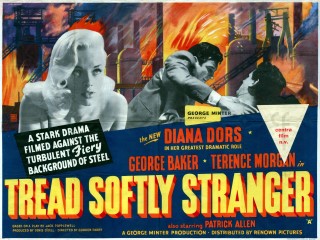
Tread Softly Stranger is a 1958 British crime drama directed by Gordon Parry and starring Diana Dors, George Baker and Terence Morgan. The film was shot in black-and-white in film noir style, and its setting in an industrial town in northern England mirrors the kitchen sink realism movement coming into vogue in English drama and film at the time. The screenplay was adapted from the stage play Blind Alley (1953) by Jack Popplewell.

Rag Doll, released in the USA as Young, Willing and Eager, is a 1961 British second feature crime film, directed by Lance Comfort and starring Christina Gregg, Kenneth Griffith, Jess Conrad and Hermione Baddeley.
Dangerous Medicine is a 1938 British crime film directed by Arthur B. Woods and starring Elizabeth Allan and Cyril Ritchard. It is now classed as a lost film.

Murder at Scotland Yard is 1953 British crime film directed by Victor M. Gover and starring Tod Slaughter, Patrick Barr and Tucker McGuire. It is a sequel to King of the Underworld (1952).

The Brain Machine is a 1956 British thriller film directed by Ken Hughes and starring Maxwell Reed, Elizabeth Allan and Patrick Barr.
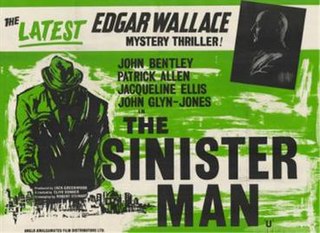
The Sinister Man is a 1961 British crime drama film directed by Clive Donner and starring Patrick Allen and John Bentley. It was one of the series of Edgar Wallace Mysteries, British second-features, produced at Merton Park Studios in the 1960s.

Never Back Losers is a 1961 British 'B' crime film directed by Robert Tronson and starring Jack Hedley, Jacqueline Ellis and Patrick Magee. The film is based on the 1929 novel The Green Ribbon by Edgar Wallace. It was one of the Edgar Wallace Mysteries series, produced at Merton Park Studios in the early 1960s.
Five Days is a 1954 British second feature film noir directed by Montgomery Tully and starring Dane Clark, Paul Carpenter and Thea Gregory.

















